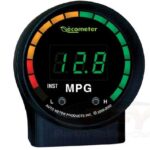A P018 code indicates a Crankshaft Position – Camshaft Position Correlation error, specifically on Bank 2 of your engine. This article discusses troubleshooting and resolving this code, focusing on a case study involving a modified 2010 Subaru WRX STI engine. We’ll explore potential causes, diagnostic steps, and solutions to help you understand and address this OBD2 error.
Understanding the P018 Code
The P018 code signifies a discrepancy between the crankshaft and camshaft position sensors on Bank 2. This mismatch can lead to rough idling, engine shaking, and potentially more severe engine problems if left unaddressed. The engine control unit (ECU) relies on precise timing information from these sensors to manage fuel injection and ignition timing. When these signals don’t align, the P018 code is triggered.
Case Study: Troubleshooting a P018 Code in a Modified Subaru STI
In a specific scenario, a modified 2010 Subaru WRX STI engine experienced a rough idle and shaking after refueling. A diagnostic scan revealed a P018 code. The initial troubleshooting steps involved:
-
Replacing the Crankshaft Position Sensor: This is a common first step when encountering a P018 code. However, in this case, replacing the sensor with a known good one did not resolve the issue. The code reappeared after resetting it and running the engine.
-
Inspecting AVCS (Active Valve Control System): Suspecting a potential issue with the AVCS system on the driver’s side (Bank 2), the owner planned to swap the AVCS components from a spare engine. This suspicion arose from observing significantly different readings between the two AVCS sensors using a Cobb Accessport. One sensor read 65 degrees, while the other read only 5 degrees. This discrepancy pointed towards a possible problem within the AVCS system affecting timing.
-
Considering Oil Passage Blockage: A blocked or clogged oil passage within the AVCS system could prevent proper timing adjustment, leading to the P018 code. The AVCS system relies on oil pressure to adjust the camshaft timing, and a restriction in oil flow can disrupt this process.
Common Causes of P018
While this case study focuses on a specific vehicle, several common issues can trigger a P018 code:
-
Faulty Camshaft or Crankshaft Position Sensors: Despite the initial replacement in the case study, these sensors remain potential culprits. It’s possible a new sensor is also defective or there’s a wiring issue.
-
Wiring Harness Problems: Damaged or corroded wiring in the sensor circuits can disrupt signal transmission, leading to the P018 code.
-
Timing Chain/Belt Issues: A stretched or slipped timing chain/belt can disrupt the synchronization between the crankshaft and camshaft, triggering the code. This is less likely in the case study given the sudden onset of the issue.
-
Oil Control Valve (OCV) Malfunction: A faulty OCV within the AVCS system can hinder proper oil flow and timing adjustment.
Resolving a P018 Code
Addressing a P018 code requires a systematic approach:
-
Thorough Visual Inspection: Check for any obvious signs of damage to wiring harnesses, connectors, and sensors.
-
Testing Sensors and Wiring: Use a multimeter to test the resistance and voltage of the camshaft and crankshaft position sensors and their associated wiring.
-
Verifying Timing Chain/Belt Alignment: If suspected, inspect the timing chain/belt for proper tension and alignment.
-
Addressing AVCS Issues: If AVCS is suspected, check for oil passage blockages or faulty OCVs. Cleaning or replacing these components may be necessary.
Conclusion
The P018 OBD2 code indicates a critical timing correlation issue between the crankshaft and camshaft. Resolving this problem requires a methodical diagnostic approach. By understanding the potential causes and employing appropriate troubleshooting techniques, you can effectively diagnose and fix the underlying issue, ensuring your engine runs smoothly and efficiently. While disabling the code might temporarily clear the error message, it won’t address the root cause. Always aim for a proper diagnosis and repair to prevent potential engine damage.

